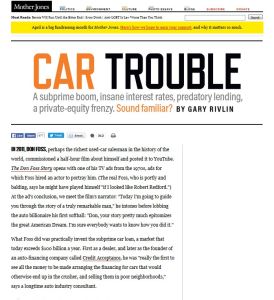Join getAbstract to access the summary!

Join getAbstract to access the summary!
Gary Rivlin
Car Trouble
Mother Jones, 2016
What's inside?
Lenders offering subprime auto loans prey on – and profit from – consumers with the poorest credit.
Recommendation
If you thought the 2008 US housing crash was the end of subprime bonds, think again. In this article, former New York Times reporter Gary Rivlin charts the rise of Wall Street’s latest billion-dollar baby: the subprime auto loan. He mainly focuses on the history of subprime auto-lending “pioneer” Don Foss’s auto-financing company Credit Acceptance, but Rivlin’s pointed analysis of the ongoing fight to regulate predatory auto lending carries broad, future-looking implications. getAbstract recommends this article to readers with an interest in the auto and financial markets.
Summary
About the Author
Former New York Times reporter Gary Rivlin is co-editor of the Economic Hardship Reporting Project. He has written five books, including Katrina: After the Flood.


















Comment on this summary